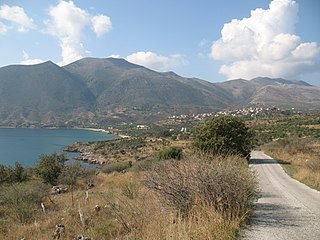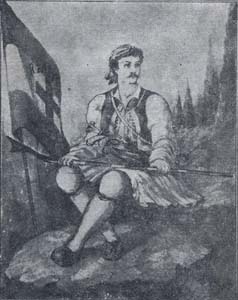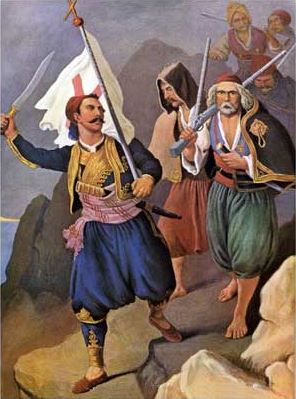Prelude
The failed Orlov Revolt had been a disaster for Mani and in 1770, the Ottoman bey of the Peloponnese, Hassán Ghazi, invaded Mani with a large force of Turko-Albanians. Their army laid siege to the Grigorakis tower in Skoutari which was garrisoned by fifteen men. The tower held out for three days until it was undermined and gunpowder was placed underneath the tower which was then set alight and blown up.
The Ottomans then advanced to the plain of 'Vromopidaga' where they defeated by the vastly outnumbered Maniots. Ghazi then lured the Maniots' leader Éxarchos and had him hung. His mother then had the men of Skoutari under Zanet trick the Turkish garrison at Passavas and sacked the city.
In 1784, Zanet was lured onto an Ottoman ship and was given the choice of his life or to accept the title of bey and Ottoman vassalage. For four years since the last Ottoman invasion, Zanet had refused offers to become bey but under the pressure of this threat he accepted. But in 1798 he was caught conspiring with French agents. He was disposed and outlawed but he continued to cause trouble for the Ottomans from his fort at Cranae. In 1803, a load of French weapons was delivered to his fort. Once the Ottomans found out, they decided it was time to stop Zanet.

The Greek War of Independence, also known as the Greek Revolution or the Greek Revolution of 1821, was a successful war of independence by Greek revolutionaries against the Ottoman Empire between 1821 and 1829. In 1826, the Greeks were assisted by the British Empire, Kingdom of France, and the Russian Empire, while the Ottomans were aided by their North African vassals, particularly the eyalet of Egypt. The war led to the formation of modern Greece, which would be expanded to its modern size in later years. The revolution is celebrated by Greeks around the world as independence day on 25 March every year.

The Mani Peninsula, also long known by its medieval name Maina or Maïna, is a geographical and cultural region in the Peloponnese of Southern Greece and home to the Maniots, who claim descent from the ancient Spartans. The capital city of Mani is Areopoli. Mani is the central of three peninsulas which extend southwards from the Peloponnese. To the east is the Laconian Gulf, to the west the Messenian Gulf. The Mani peninsula forms a continuation of the Taygetos mountain range, the western spine of the Peloponnese.

The Great Turkish War, also called the Wars of the Holy League, was a series of conflicts between the Ottoman Empire and the Holy League consisting of the Holy Roman Empire, Poland-Lithuania, Venice, Russia, and the Kingdom of Hungary. Intensive fighting began in 1683 and ended with the signing of the Treaty of Karlowitz in 1699. The war was a defeat for the Ottoman Empire, which for the first time lost substantial territory, in Hungary and the Polish–Lithuanian Commonwealth, as well as in part of the western Balkans. The war was significant also for being the first instance of Russia joining an alliance with Western Europe.

Skoutari is a village and a community of the municipality of East Mani. Before the 2011 local government reform it was a part of the municipality of Gytheio, of which it was a municipal district. The 2011 census recorded 234 residents in the village and 293 residents in the community. The community of Skoutari covers an area of 11.667 km2. According to local tradition it was founded by refugees from the Fall of Constantinople in 1453.

The Battle of Vromopigada was fought between the Ottoman Turks and the Maniots of Mani in 1770. The location of the battle was in a plain between the two towns of Skoutari and Parasyros. The battle ended in a Greek victory.
Las, or Laas (Λάας), or La (Λᾶ), was one of the most ancient towns of Lakedaimonia, located on the western coast of the Laconian Gulf. It is the only town on the coast mentioned in the Periplus of Pseudo-Scylax between Taenarus and Gythium. The Periplus speaks of its port; but, according to Pausanias, the town itself was distant 10 stadia from the sea, and 40 stadia from Gythium. In the time of Pausanias the town lay in a hollow between the three mountains, Asia, Ilium, and Cnacadium; but the old town stood on the summit of Mt. Asia. The name of Las signified the rock on which it originally stood. It is mentioned by Homer in the Catalogue of Ships in the Iliad, and is said to have been destroyed by the Dioscuri, who hence derived the surname of Lapersae. There was also a mountain in Laconia called Lapersa.

The Ottoman–Egyptian invasion of Mani was a campaign during the Greek War of Independence that consisted of three battles. The Maniots fought against a combined Egyptian and Ottoman army under the command of Ibrahim Pasha of Egypt.

The Maniots or Maniates are an ethnic Greek subgroup that traditionally inhabit the Mani Peninsula; located in western Laconia and eastern Messenia, in the southern Peloponnese, Greece. They were also formerly known as Mainotes, and the peninsula as Maina.

The 1770 Ottoman Invasion of Mani was one of a series of invasions by the Ottomans to subdue the Maniots. Mani was one region of Greece that the Ottomans had not occupied due to the rough terrain and the rebellious spirit of Maniots. The Maniots caused damage to the Ottomans by allying with the Venetians whenever there was a war between Venice and the Ottomans, and also habitually engaged in piracy.

The 1815 Ottoman Invasion of Mani was one of a series of invasions by the Ottomans to subdue the Maniots. Mani was the only region of Greece that the Ottomans had not occupied due to the rough terrain and the rebellious spirit of the Maniots. The Maniots caused damage to the Ottomans by allying with the Venetians whenever there was a war between Venice and the Ottomans. They also practiced piracy.

The 1807 Ottoman Invasion of Mani was one of a series of invasions by the Ottomans to subdue the Maniots. Mani was the only region of Greece that the Ottomans had not occupied due to the rough terrain and the rebellious spirit of the Maniots. The Maniots caused damage to the Ottomans by allying with the Venetians whenever there was a war between Venice and the Ottomans; they also were pirates.
The siege of Kastania was fought in July 1780 between the Maniots and the klephts under Konstantinos Kolokotronis and Panagiotaros Venetsakis and the Ottoman Empire under Ali Bey.

Zacharias Pantelakos, nicknamed Barbitsiotis but more commonly known as Kapetan Zacharias, was a Greek klepht in the Peloponnese during the last decades of Ottoman rule over Greece. He is described by Kyriakos Kassis as the best klepht of Taygetus.

The Morean war, also known as the Sixth Ottoman–Venetian War, was fought between 1684–1699 as part of the wider conflict known as the "Great Turkish War", between the Republic of Venice and the Ottoman Empire. Military operations ranged from Dalmatia to the Aegean Sea, but the war's major campaign was the Venetian conquest of the Morea (Peloponnese) peninsula in southern Greece. On the Venetian side, the war was fought to avenge the loss of Crete in the Cretan War (1645–1669). It happened while the Ottomans were entangled in their northern struggle against the Habsburgs – beginning with the failed Ottoman attempt to conquer Vienna and ending with the Habsburgs gaining Buda and the whole of Hungary, leaving the Ottoman Empire unable to concentrate its forces against the Venetians. As such, the Morean War was the only Ottoman–Venetian conflict from which Venice emerged victorious, gaining significant territory. Venice's expansionist revival would be short-lived, as its gains would be reversed by the Ottomans in 1718.

Liverios Gerakaris, more commonly known by the hypocoristic Limberakis, was a Maniot pirate who later became Bey of Mani.
The Battle of Valtetsi was fought on 24 May (N.S.), 1821 in Valtetsi between the Ottoman army and Greek revolutionaries.

The Liberation of Kalamata took place on 23 March (O.S.) 1821 when Greek irregular revolutionary forces took control of the city after the surrender of the Ottoman garrison, without fighting. It was one of the first events of the Greek War of Independence. Kalamata became the first major town to be liberated.
Konstantinos Kolokotronis was a notable Greek klepht leader in the third quarter of the 18th century in the Peloponnese, and the father of Theodoros Kolokotronis, one of the leaders of the Greek War of Independence.
The Greek Legion, officially the Light Jäger Foot Legion, was a Jäger infantry unit in the service of the Russian-controlled Septinsular Republic. It consisted of soldiers of Greek and Albanian origin and was led by Major-General Emmanouil Papadopoulos. It was active between 1805 and 1807, taking part in the War of the Third Coalition and the Russo-Turkish War (1806–1812).
Tzanetos "Kapetanakis" Grigorakis, also known as Zanetos or Tzanibey or Zanibey or Tzanetbey or Zanetbey, was a Greek politician, general and the 3rd bey of Mani, the most prominent together with Petrobey Mavromichalis. He was the longest-ruling bey of the Maniots, serving for 16 years, from 1782 to 1798.










